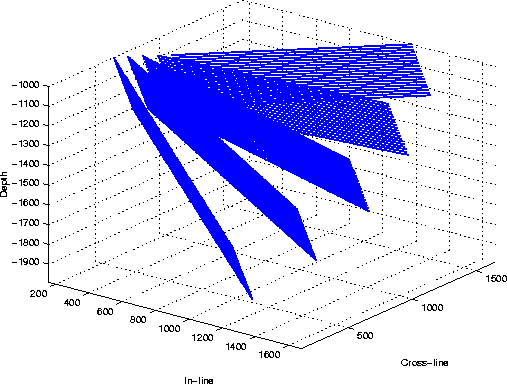|
planes
Figure 1 5 reflectors with an azimuth of 45 and dips from 0 to 60.The velocity function is v=1500+0.5 z m/s. |  |
Migration velocity analysis combines migration and velocity analysis in an iterative process. After each migration, if the velocity model is not correct, the events in the common-image gathers (CIGs) are not flat. Migration velocity analysis uses the residual move-out (RMO) in the gathers to update the velocity model.
Wavefield-continuation migration offset-domain common-image gathers (ODCIGs) generated are inconvenient for extracting velocity information. Conversely, wavefield-continuation migration angle-domain common-image gathers (ADCIGS) are convenient because their energy is spread over the gather, similar to ODCIGs in Kirchhoff migration. In addition, ADCIGs avoid ambiguities of the reflector positions in Kirchhoff ODCIGs when multipathing occurs Prucha et al. (1999).
The ADCIGs can be formed during the imaging step of the wavefield-continuation migration Prucha et al. (1999); de Bruin et al. (1990). In this case, the ADCIGs are expressed in terms of the offset ray-parameter instead of the aperture angle. Sava and Fomel (2003) propose a method applied after imaging to obtain ADCIGs as functions of the direct aperture angle. Pointing out that the method is valid only for reflectors orthogonal to the acquisition direction (dip-reflection), and consequently ignores the azimuth angle of the reflection, Biondi and Tisserant (2004) generalize it to 3-D. The resulting ADCIGs are not only function of aperture angle, but also function of reflection azimuth angle.
As well as providing additional information to perform velocity analysis, the knowledge of the reflection azimuth can also be used to correctly backproject rays in reflection tomography, or to perform amplitude-versus-angle analysis along the reflection azimuth at the image point rather than along the acquisition azimuth.
Biondi and Symes (2003) analyze the kinematics of the ADCIGs in the presence of velocity error and derive an RMO function. Biondi and Tisserant (2004) extend this study to 3-D. This paper describes the estimation of the velocity error from 3-D ADCGIs in order to update the velocity model. We first review the additional information contained by the 3-D ADCIGs. We then quantify the velocity error from the ADCIGs with a 2-D RMO function. The last part describes how accounting for the 3-D wave propagation improves the estimation of the velocity error. The method is tested on the synthetic model displayed in Figure 1. The model consists of 5 dipping planes in a linearly increasing velocity v(z)=1500+.5z m.s-1. The planes have a 45 azimuth. The dataset is migrated with a full prestack wavefield-continuation migration and a velocity that is 3% too low.
|
planes
Figure 1 5 reflectors with an azimuth of 45 and dips from 0 to 60.The velocity function is v=1500+0.5 z m/s. |  |